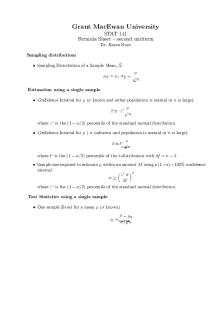Homosporous v - Lecture notes 2 PDF

| Title | Homosporous v - Lecture notes 2 |
|---|---|
| Course | Biochemistry I |
| Institution | The University of Texas at Dallas |
| Pages | 3 |
| File Size | 83.4 KB |
| File Type | |
| Total Downloads | 55 |
| Total Views | 150 |
Summary
finalize note for exam 1...
Description
Homosporous v. Heterosporous Plants Homosporous plants are only able to produce one type of spore; this means that the spores produced are bisexual gametophytes. Heterosporous plants produce two types of spores; one is male and one is female. Male spores are known as microspores, and have a smaller size when compared to female spores. Female spores are known as megaspores; they are larger than microspores. Mnemonic: For both spores and human gametes, the female variant is larger and the male variant is smaller.
Bryophytes Bryophytes are nonvascular plants. Examples of bryophytes are mosses, hornworts, and liverworts. As the word “nonvascular” suggests, most bryophytes do not have vascular tissue, which we know is how many plants transport materials throughout the plant. Bryophytes also do not have roots. This limitation forces bryophytes to be relatively simple. Bryophytes must remain small and short. Think about it: if bryophytes were tall, they would have no effective way of getting water and nutrients up to the top. They grow horizontally so that everything can be near the water and nutrient source (think about a moss growing horizontally along a tree stump). With all this in mind, it makes a lot of sense that bryophytes are mostly found in moist habitats. Although bryophytes do not have roots, they do contain rhizoids (hair-like projections) which aid in water absorption and provide minor anchorage. Bryophytes spend most of their life cycle in the gametophyte stage. They possess flagellated sperm (gametophytes stage). Bryophytes use spores as their dispersal unit (sporophyte stage). They have a reduced sporophyte, which consists of a seta, foot, and sporangia. The sporophyte is usually dependent on and attached to the gametophyte for survival.
Tracheophytes
Tracheophytes are vascular plants, plants that contain xylem and phloem vessels. These vessels provide an effective means of transporting water and nutrients to different areas of the plant, allowing tracheophytes to grow vertically and tall (think of a tree). They also have a root system which anchors them in place. Tracheophytes spend most of their life cycle in the sporophyte stage.
There are two types of vascular plants: those that are seedless and those that have seeds. The presence of seeds in a plant shows great evolutionary advancement. Seeds are more resilient and durable (remember the nutritious endosperm and the protective seed coat!), allowing them to disperse more effectively and get planted and grow into a mature plant more successfully.
Seedless tracheophytes include the phylums Lycophytes and Pterophytes. Common examples include club moss, quillworts, fern, and horsetail. Ferns formed the first forests during the Carboniferous period. Although most are found in moist habitats, their vascular system allows them to successfully grow in more dry climates as well. Most seedless tracheophytes are heterosporous (can produce both male and female spores). Seedless tracheophytes have flagellated sperm, meaning they can move on their own (they do not travel via wind or animal transport).
Seed-bearing tracheophytes can be further broken into two groups: gymnosperms and angiosperms. All seed-bearing tracheophytes are heterosporous. Gymnosperms are seed-bearing tracheophytes whose seeds are not protected (sometimes called a naked-seed). The most common example are conifers (cone-bearing plants). Examples of conifers include fir, spruce, redwood, and pine. Gymnosperms were the first seed plant on earth (meaning they appeared before angiosperms). Most gymnosperms do not have flagellated sperm - the sperm are dispersed by wind. Seeds are their dispersal unit, and their dominant generation is sporophyte.
Angiosperms are seed-bearing tracheophytes that are also flower-bearing, and can produce fruit. Their seeds are protected, located in the fruit (considered the ovary of the plant). These are the most abundant type of plant living today. Angiosperms do not have flagellated sperm - all their sperm is wind or animal dispersed (often as pollen). Pollen is another example of evolutionary advancement - it is a highly efficient way of achieving fertilization.
Many angiosperms package their sperm in these small, easily movable pollen grains, which can easily be picked off one flower and deposited on another flower (fertilization) by the wind or by an animal (like a bee). They have more opportunities and ways to fertilize and get fertilized. Most angiosperms (and some gymnosperms) can exhibit double fertilization. Double fertilization is when a female gamete is fertilized by two male gametes or sperm. This will be further explained in the next section on Flower Structures....
Similar Free PDFs

Homosporous v - Lecture notes 2
- 3 Pages

Unit V - Lecture notes 5th
- 18 Pages

Henningsen v - Lecture notes 1
- 3 Pages

Lecture notes, lecture 2
- 3 Pages

Maryland v. Buie Lecture Notes
- 2 Pages

2 - Lecture notes 2
- 5 Pages
![[COMP]+HYYH+Notes+-+ENG+v lecture notes](https://pdfedu.com/img/crop/172x258/1n2jg9vlwx2q.jpg)
[COMP]+HYYH+Notes+-+ENG+v lecture notes
- 157 Pages

Lecture notes, lecture Chapter 2
- 11 Pages

Lecture notes, lecture formula 2
- 1 Pages
Popular Institutions
- Tinajero National High School - Annex
- Politeknik Caltex Riau
- Yokohama City University
- SGT University
- University of Al-Qadisiyah
- Divine Word College of Vigan
- Techniek College Rotterdam
- Universidade de Santiago
- Universiti Teknologi MARA Cawangan Johor Kampus Pasir Gudang
- Poltekkes Kemenkes Yogyakarta
- Baguio City National High School
- Colegio san marcos
- preparatoria uno
- Centro de Bachillerato Tecnológico Industrial y de Servicios No. 107
- Dalian Maritime University
- Quang Trung Secondary School
- Colegio Tecnológico en Informática
- Corporación Regional de Educación Superior
- Grupo CEDVA
- Dar Al Uloom University
- Centro de Estudios Preuniversitarios de la Universidad Nacional de Ingeniería
- 上智大学
- Aakash International School, Nuna Majara
- San Felipe Neri Catholic School
- Kang Chiao International School - New Taipei City
- Misamis Occidental National High School
- Institución Educativa Escuela Normal Juan Ladrilleros
- Kolehiyo ng Pantukan
- Batanes State College
- Instituto Continental
- Sekolah Menengah Kejuruan Kesehatan Kaltara (Tarakan)
- Colegio de La Inmaculada Concepcion - Cebu






